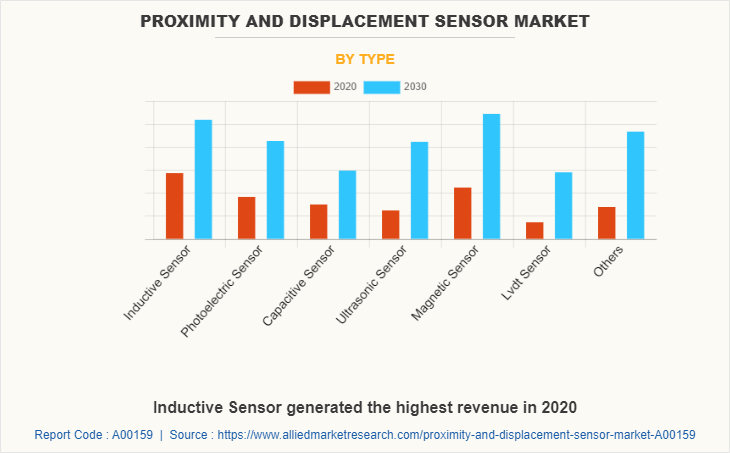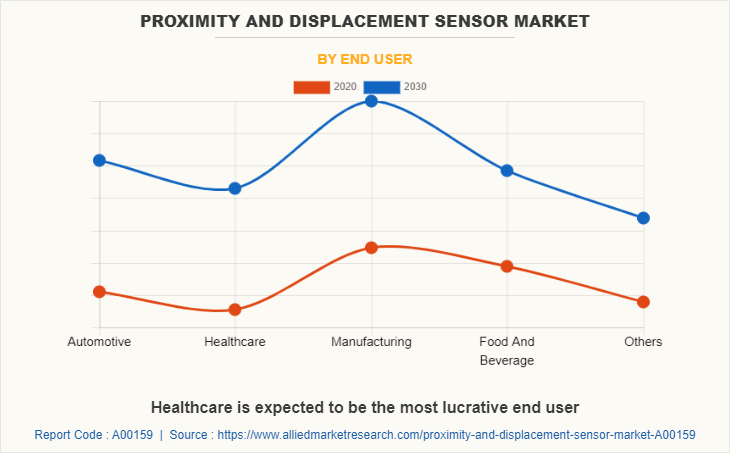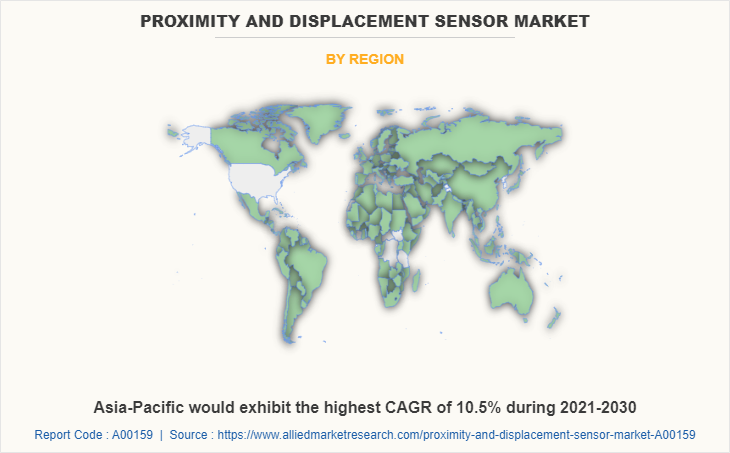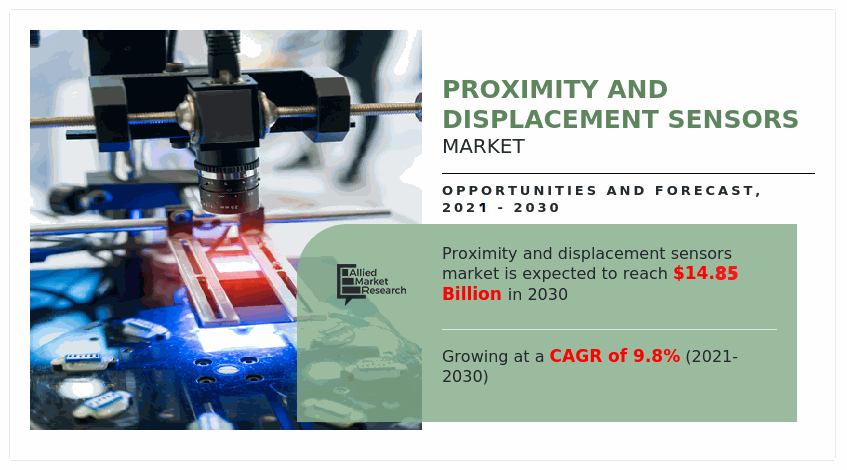Proximity and Displacement Sensors Market Outlook – 2030
The global proximity and displacement sensors market size was valued at $5.89 billion in 2020, and is projected to reach $14.85 billion by 2030, registering a CAGR of 9.8% from 2021 to 2030.
A proximity sensor is a sensor integrated in a system to detect the presence of an object within the vicinity of the sensor. The sensor features non-contact detection that ensures a high degree of reliability and durability. A displacement sensor measures the position or displacement of an object from one point to another. Presently, the market for proximity and displacement sensors is in a progressive phase of its product life cycle. Increase in demand for these sensors in the development of factory and process automation systems has witnessed significant proximity and displacement sensors market.
The ongoing trend of process automation in factories and the continuous growth in the mobile devices market are the major drivers for the proximity and displacement sensor market. In addition, the declining price of sensors is expected to drive the proximity and displacement sensor market growth exponentially. Growth in popularity of contactless sensing applications and an increase in interest of automobile manufacturers toward integrating sensor technology in automotive security and infotainment systems are expected to gradually uplift the proximity and displacement sensors market share globally.
The value chain of the proximity and displacement sensors market trends includes various stakeholders, such as manufacturers of components, 3D software developers, original equipment manufacturers, utility solution manufacturers, and service providers. Each of these players shares a specific value at their point of operation, which, in turn, contributes to the competitive value of the product. R&D activities, innovations, marketing strategies, and aesthetic concerns enhance the overall value associated with the end deliverable by each player in the proximity and displacement sensor market outlook. The proximity and displacement sensors market trends include a surge in digitization and a rise in applications of smart technologies across regions.
In the moderate case scenario, the proximity and displacement sensors market forecast is anticipated to continue to grow at a constant rate. The application of wireless proximity sensors and displacement sensors in automobiles, manufacturing automation, and mobile devices shows stagnant growth. The market may not evolve in terms of new applications. The automobile market is likely to support the proximity and displacement sensors industry with existing applications, such as intelligent parking systems and ground proximity warning systems. Manufacturing sectors may exhibit slower growth, due to which the automation technologies would foresee a lower growth rate. All these factors lead to a gradual proximity and displacement sensors market growth.
Segment Overview
The proximity and displacement sensors market is segmented based on type, end user, and region.
By type, the market is segmented into inductive sensor, photoelectric sensor, capacitive sensor, ultrasonic sensor, magnetic sensor, LVDT sensor, and others.

Based on end user, the market is segregated into automotive, healthcare, manufacturing, food and beverage, and others.

By region, the market is analyzed across North America, Europe, Asia-Pacific, and LAMEA along with its prominent countries.

Competitive Analysis
The prominent players in the industry are Omron Corporation, IFM Electronics GmbH, Kaman Corporation, Keyence Corporation, Lion Precision, Micron Optics Inc., Panasonic Corporation, Pepperl+Fuchs, Standex-Meder Electronics Inc., and Turck Inc. These key players have adopted various strategies, such as product portfolio expansion, mergers & acquisitions, agreements, geographical expansion, and collaborations to enhance their market penetration.
New projects globally are stalled, which, in turn, has affected the demand for proximity and displacement sensors in several industries, including manufacturing, industrial, and retail. Although market players face minimal impact on procuring raw materials, time and shipping costs are still major concerns, which hamper the market growth. Moreover, a rise in investments in the development of smart cities has gained importance during the pandemic. Subsequently, the demand for proximity and displacement sensors is anticipated to gain momentum post-pandemic.
Key market players focus on positioning their companies for a strong recovery after the pandemic. These market players have meticulously planned to strengthen their supply chain to benefit from post-pandemic opportunities. They further focus on availing additional opportunities with expanded market usage of proximity and displacement sensors technology, owing to price considerations, use of proximity and displacement sensors market technology, and additional display offerings using micro-lenses. Hence, market players are anticipated to boost the market growth owing to various opportunities generated post-pandemic. Although COVID-19 has had a major negative impact on the growth of the market, the outbreak of COVID-19 is expected to provide numerous opportunities for the market growth during the forecast period.
Top Impacting Factors
Rise in the Trend of Factory Process Automation
Factory automation is a major application area of proximity and displacement sensors. The proximity sensor is a crucial part of the automation systems, which is used for object detection and signaling the processor to initiate the specific process assigned to it. Manufacturers are looking for factory automation solutions as an optimum alternative, specifically in the areas where the manufacturing process requires repeatability and quality standards are stringent, thus driving the proximity and displacement sensors market analysis.
Cost of Automation
The proximity and displacement sensors market seeks factory and process automation as the prime area of application in terms of revenue. Automation involves the installation of robotic structures embedded with intelligent sensing technology, which operate with or without a negligible amount of human supervision. However, the implementation of a fully integrated automation system attracts a huge amount of initial investment, which subsequently dilutes the interest of medium- and small-sized manufacturers. However, the high cost associated with establishing an automation system is expected to provide benefits, such as concurrent task allocation feasibility and enhanced productivity, which can rapidly cover the initial investment cost. Thereby, boosting the proximity and displacement sensors market opportunity.
Emerging Concept of Smart Homes
Smart home is defined as a habitation furnished with technology that observes conditions of a residence and provides proactive services. The smart home concept emerged to offer two major facilities, such as safety and security, assisted living for residents, and luxury amenities. Proximity and displacement sensors are expected to find numerous opportunities in the future, such as in home safety & security and assisted living applications, including smoke detection, automated lighting, and air conditioning.
Key Benefits For Stakeholders
- This report provides a quantitative analysis of the market segments, current trends, estimations, and dynamics of the proximity and displacement sensor market from 2020 to 2030 to identify the prevailing market opportunities.
- The market research is offered along with information related to key drivers, restraints, and opportunities.
- Porter's five forces analysis highlights the potency of buyers and suppliers to enable stakeholders to make profit-oriented business decisions and strengthen their supplier-buyer network.
- In-depth analysis of the proximity and displacement sensor market segmentation helps determine the prevailing market opportunities.
- Major countries in each region are mapped according to their revenue contribution to the global market.
- Market player positioning facilitates benchmarking and provides a clear understanding of the present position of the market players.
- The report includes the analysis of the regional as well as global proximity and displacement sensor market trends, key players, market segments, application areas, and market growth strategies.
Proximity and Displacement Sensors Market Report Highlights
| Aspects | Details |
| By Type |
|
| By End User |
|
| By Region |
|
| Key Market Players | Pepperl+Fuchs, Panasonic Corporation, Keyence Corporation, Kaman Corporation, Turck Inc., Lion Precision, Micron Optics Inc., IFM Electronics GmbH, Standex-Meder Electronics Inc., Omron Corporation |
Analyst Review
Recovering economies coupled with efforts of manufacturing companies toward improving their production efficiency drives the factory automation trend globally. In addition, recent upsurge in automobile production in Asian countries such as China, India, and Japan drives the growth of the automotive industry. Ultimately leading to the growth in the end-user industries, which deploy proximity and displacement sensors. Thus driving the proximity and displacement sensors market.
Proximity and displacement sensors witness extensive demand in the end-user industries, including manufacturing, automobiles, electronics, and elevators & escalators. The industry players focus on progressing areas, such as metals & mining and healthcare. The key vendors supplying high-end and technologically advanced products focus on maintaining competitive price levels in the market. Cost of automation is one of the hurdles for the market growth. Presently, decline in prices of sensors is expected to reduce the impact of this factor. Improvement in electronic technology, economies of scale, production, and manufacturing in low-cost regions are some other factors that contribute to reduction in prices of these sensors in the global market. Presently, inductive sensors find applications in detecting objects and motion controls, and are being widely used among all types of proximity and displacement sensors. Market players continuously develop new products to meet the emerging the needs of customers as well as to provide customized solutions as per their demand. Thus driving the growth of the proximity and displacement sensors market during the forecast period
Emerging Concepts of smart homes are the upcoming trends in proximity and displacement sensors market globally
Healthcare is the leading application for proximity and displacement sensor market
Asia-Pacific is the largest regional market for proximity and displacement sensor
The global proximity and displacement sensor market size was valued at $5.89 billion in 2020.
The prominent players in the market are IFM Electronics GmbH, Kaman Corporation, Keyence Corporation, Lion Precision, Micron Optics, Inc., Omron Corporation, Panasonic Corporation, Pepperl+Fuchs, Standex-Meder Electronics Inc., and Turck Inc
Loading Table Of Content...



